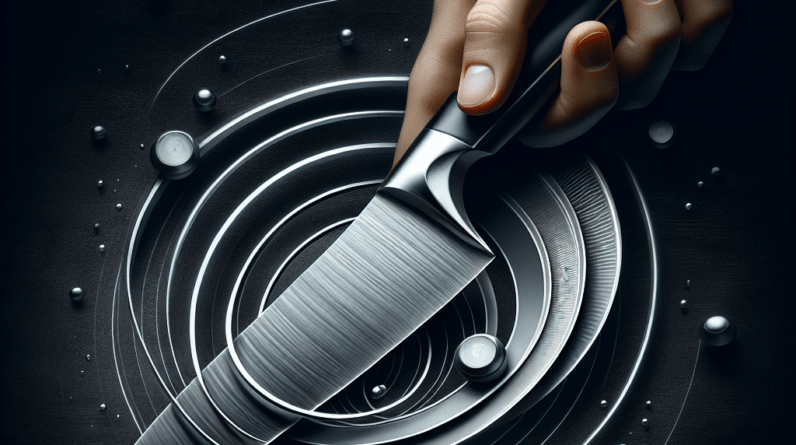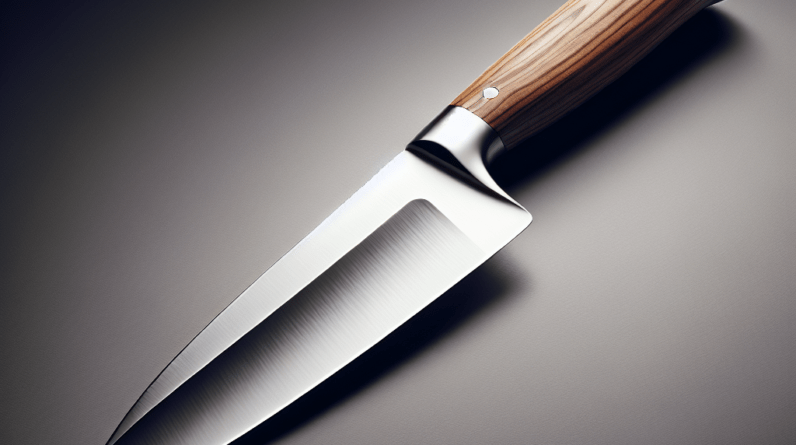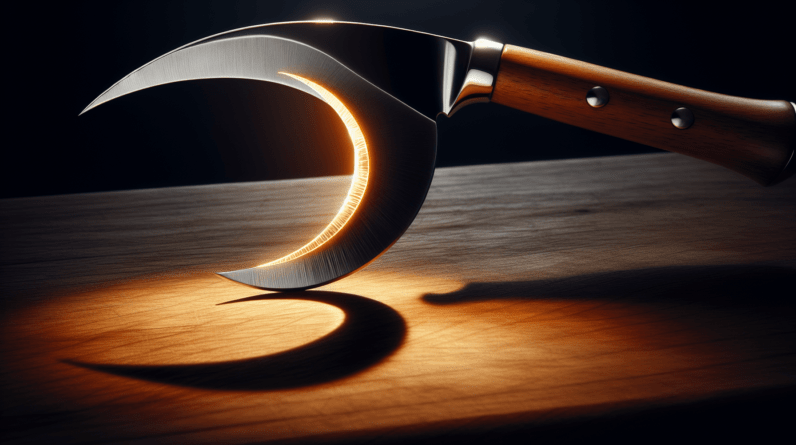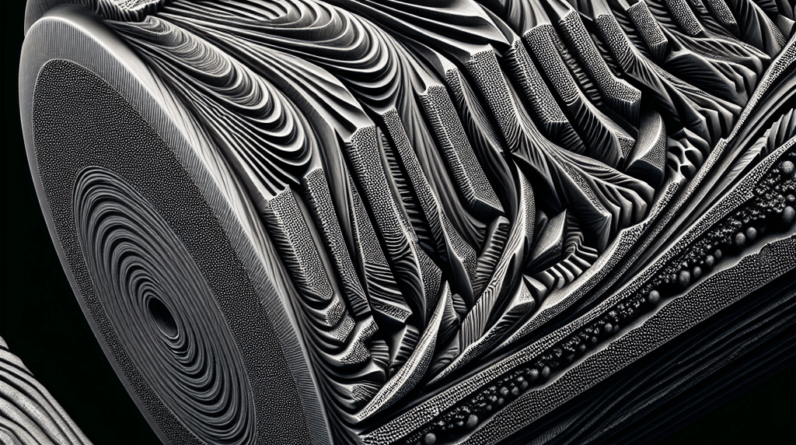Maintaining the sharpness of a serrated knife may seem like a daunting task, but fear not – we’re here to help! Whether you’re a cooking enthusiast or just someone who enjoys a good slice of bread without any squishing, keeping your serrated knife in top-notch condition is key. In this article, we will share some simple yet effective tips on how to maintain the sharpness of a serrated knife, ensuring that it remains a reliable tool in your culinary adventures. So grab your knife, and let’s get sharpening!
Cleaning the Serrated Knife
Removing Food Residue
When it comes to maintaining the sharpness of a serrated knife, proper cleaning is essential. After every use, it is important to remove any food residue that may be stuck between the serrations. To do this, we can use a soft-bristled brush or a toothbrush. Gently run the brush along the edge of the blade, making sure to reach into the crevices of the serrations. Be careful not to apply too much pressure, as this can potentially damage the blade.
Hand Washing the Knife
To ensure the longevity of a serrated knife, it is best to hand wash it rather than running it through the dishwasher. Dishwashers can cause the blade to become dull and may even lead to rusting. When hand washing, use warm water and a mild detergent. Gently scrub the blade with a sponge or dishcloth, paying extra attention to the serrations. Rinse the knife thoroughly and dry it immediately to prevent any water spots or rust from forming.
Drying the Knife Properly
After cleaning the serrated knife, it is crucial to dry it properly to avoid any moisture-related issues. Use a clean kitchen towel or paper towel to dry the knife, making sure to reach into the serrations and along the blade. Ensure that no water droplets remain on the blade before storing it, as this can promote the growth of bacteria or lead to rust formation. Remember, a dry knife is a happy knife!
Using a Sharpening Rod
Choosing the Right Sharpening Rod
A sharpening rod, also known as a honing rod or sharpening steel, is a useful tool for maintaining the sharpness of a serrated knife. When selecting a sharpening rod, it is important to choose one that is slightly longer than the blade of the knife. Additionally, ensure that the rod has a hardness level similar to that of the knife’s blade. This will ensure effective sharpening without damaging the serrations.
Proper Technique for Sharpening
Using a sharpening rod requires a specific technique to effectively sharpen a serrated knife. Begin by holding the rod vertically, with the tip resting on a secure surface. Place the serrated knife at the base of the rod, aligning the serrations with the grooves of the rod. Maintaining a 15-20 degree angle, gently draw the knife down the rod, from the base to the tip, while applying light pressure. Repeat this process for each serration, being careful not to over-sharpen or damage the blade.
Frequency of Sharpening
The frequency of sharpening a serrated knife can vary depending on its usage. As a general guideline, it is recommended to sharpen the knife every two to three months or when it starts to feel dull. However, if the knife is used extensively or for heavy-duty tasks, it may require more frequent sharpening. Regular inspection and sharpening will help ensure that the knife consistently performs at its best.

Using a Whetstone
Selecting the Right Whetstone
When it comes to sharpening a serrated knife, using a whetstone can be an effective method. However, it is crucial to select the right type of whetstone. Opt for a fine-grit whetstone, preferably one specifically designed for sharpening serrated knives. The size of the whetstone should also be considered, ensuring it is large enough to accommodate the length of the serrated knife blade.
Preparing the Whetstone
Before using a whetstone to sharpen a serrated knife, it is necessary to properly prepare the stone. Begin by soaking it in water for around 10 to 15 minutes. This allows the stone to absorb water and prevents it from drying out during the sharpening process. Once the stone is adequately soaked, place it on a stable surface with a towel underneath to prevent slipping.
Sharpening Technique
To sharpen a serrated knife using a whetstone, hold the knife with the serrations facing away from you. Starting from the base of the blade, place the serrations into the grooves of the whetstone. Maintain a 15-20 degree angle and move the knife back and forth along the whetstone, working from the base to the tip. Use consistent and gentle pressure while sharpening each serration. Repeat this process for all the serrations, ensuring each receives equal attention.
Using a Sharpening System
Choosing a Suitable Sharpening System
A sharpening system can be a convenient and efficient way to maintain the sharpness of a serrated knife. When selecting a sharpening system, consider one specifically designed for serrated knives. Choose a system that offers adjustable angles and abrasive materials suitable for sharpening serrations. Additionally, ensure the system comes with detailed instructions to help achieve optimal results.
Setting Up the Sharpening System
Proper setup of the sharpening system is crucial to achieve effective results. Follow the manufacturer’s instructions carefully to assemble the system correctly. Ensure that the system is stable and secure before beginning the sharpening process. Familiarize yourself with the different components and how they function to ensure a smooth sharpening experience.
Step-by-Step Sharpening Process
Using a sharpening system typically involves a step-by-step process to successfully sharpen a serrated knife. Start by determining the angle recommended for sharpening serrations, usually between 15-20 degrees. Adjust the system accordingly. Next, hold the serrated knife securely in the system, aligning the serrations with the appropriate sharpening mechanism. Gently move the knife along the system, ensuring each serration receives equal attention. Follow the manufacturer’s instructions regarding the number of passes required for optimal sharpening. Once complete, remove the knife and inspect the serrations for sharpness.

Avoiding Improper Usage
Cutting on Appropriate Surfaces
To maintain the sharpness of a serrated knife, it is crucial to use it on appropriate cutting surfaces. Avoid cutting on hard surfaces such as glass, stone, or metal, as these can cause the serrations to become dull or damaged. Instead, opt for cutting boards made of wood, plastic, or bamboo. These materials will help preserve the sharpness of the blade and extend its lifespan.
Avoiding Hard Materials
Serrated knives are designed to cut through soft or delicate foods with ease. To avoid damage to the serrations, refrain from using the knife on hard materials such as bones, frozen foods, or crusty bread. Excessive force and contact with hard surfaces can lead to bent or broken serrations, compromising the knife’s functionality. Always choose an appropriate tool for heavy-duty tasks to preserve the serrated knife’s sharpness.
Using the Knife for its Intended Purpose
While a serrated knife can be versatile in its applications, it is essential to use it for its intended purpose. Using the knife for tasks that require a different type of blade, such as a boning or chef’s knife, can lead to unnecessary damage. Use the serrated knife for tasks such as slicing bread, cakes, or tomatoes, where the serrations can make clean and precise cuts. Proper usage of the knife will help preserve its sharpness for longer periods.
Storing the Serrated Knife
Using a Knife Block
Proper storage is vital to maintain the sharpness of a serrated knife. When not in use, storing the knife in a knife block can help protect the blade and prevent dulling. Choose a knife block that has appropriate-sized slots for serrated knives, ensuring the blade fits securely. The block should also have inserts or bristles that separate the knives, preventing them from rubbing against each other and potentially causing damage.
Using a Magnetic Strip
An alternative storage option for a serrated knife is a magnetic strip. These strips allow the knife to be easily accessible while securely holding it in place. When using a magnetic strip, ensure that it is positioned away from other metallic objects to avoid any potential damage or scratching to the blade. Clean the knife before placing it on the strip to prevent any food residue from accumulating.
Individual Knife Protectors
For added protection and to prevent the serrated knife from coming into contact with other utensils, individual knife protectors can be used. These protectors are usually made of durable materials such as plastic or felt and can slip over the blade of the knife. By using individual protectors, the knife can be safely stored in a drawer or countertop without the risk of the serrations being damaged or dulled.

Regular Maintenance Checks
Inspecting the Blade for Damage
Regularly inspecting the blade of a serrated knife is essential to identify any signs of damage or wear. Check for any bent or broken serrations, chips in the blade, or signs of corrosion or rust. If any damage is found, it is important to address it promptly. Minor issues can often be rectified with sharpening, while more severe damage may require professional assistance or even a replacement.
Checking for Loose Handles
In addition to inspecting the blade, it is equally important to check the handle of a serrated knife. Loose or damaged handles can compromise the overall stability and safety of the knife. Inspect the handle for any signs of cracks, loose rivets, or separation from the blade. If any issues are detected, it is advisable to consult a professional for repair or consider replacing the knife to ensure safe and optimal usage.
Addressing Any Issues Promptly
When performing regular maintenance checks on a serrated knife, it is crucial to address any issues promptly. Delaying repairs or neglecting maintenance can lead to further damage or accidents. Whether it is sharpening, handling repairs, or seeking professional assistance, it is important to take the necessary steps to rectify any identified issues. By doing so, the sharpness and functionality of the serrated knife can be maintained for extended periods.
Proper Knife Handling
Using the Correct Cutting Technique
To maintain the sharpness of a serrated knife, it is important to use the correct cutting technique. When slicing through food items, allow the serrations to do the work. Apply minimal downward pressure and instead rely on a gentle sawing motion. This will prevent unnecessary wear on the serrations and ensure clean and precise cuts. Avoid rocking or twisting the knife, as this can cause the serrations to become dull or potentially chip the blade.
Avoiding Excessive Force
While a serrated knife can effectively cut through various foods, it is important to avoid using excessive force. The serrations are designed to do the cutting, so there is no need to apply heavy pressure. Excessive force can lead to bent or broken serrations and may even cause the blade to slip, posing a safety hazard. By using a light and controlled grip, we can maintain the sharpness of the serrated knife while ensuring safe handling.
Properly Holding the Knife
Properly holding a serrated knife is essential for both effective cutting and personal safety. Grip the handle firmly with your dominant hand, ensuring a comfortable and secure hold. Tuck your fingers underneath the handle, allowing for better control and stability. Avoid holding the knife too close to the blade or gripping it too tightly, as this can restrict movement and potentially lead to accidents. By holding the knife correctly, we can maintain sharpness and reduce the risk of injury.
Seeking Professional Sharpening Services
Identifying the Need for Professional Sharpening
While regular maintenance can significantly extend the sharpness of a serrated knife, there may still be occasions when professional sharpening is required. Signs that indicate the need for professional sharpening include severe dullness, chips in the blade, or significant damage to the serrations. Additionally, if DIY sharpening techniques have not yielded satisfactory results, it may be time to seek the expertise of a professional.
Finding a Reliable Sharpening Service
When seeking professional sharpening services for a serrated knife, it is important to find a reliable and reputable service provider. Ask for recommendations from friends, family, or culinary professionals who may have used a similar service. Research local businesses, read reviews, and look for certifications or qualifications that demonstrate the service provider’s expertise. Choosing a reliable sharpening service will ensure the serrated knife receives the utmost care and attention.
Considerations for DIY Sharpening vs Professional Services
Deciding between DIY sharpening and professional services depends on various factors. DIY methods can be cost-effective and convenient for minor maintenance. However, professional services offer specialized equipment, knowledge, and precision that may yield better results, especially for heavily damaged or delicate serrated knives. Consider the complexity of the sharpening required, the extent of damage, and personal skill level before determining the most suitable option for maintaining the sharpness of the serrated knife.
Educating Others on Knife Maintenance
Teaching Proper Knife Usage
One effective way to promote the maintenance of a serrated knife’s sharpness is by educating others on proper knife usage. When using a serrated knife in a group or family setting, take the time to teach others the correct techniques for cutting and handling the knife. Emphasize the importance of a gentle sawing motion and avoiding excessive force to maintain the serrations’ effectiveness. By sharing this knowledge, we can contribute to the longevity of serrated knives in various environments.
Sharing Maintenance Tips
Sharing maintenance tips with friends, family, and fellow cooking enthusiasts can be invaluable in preserving the sharpness of serrated knives. Discuss the importance of regular cleaning, proper storage, and regular maintenance checks. Share the different sharpening methods and techniques discussed above, providing insights based on personal experiences. Through these conversations, we can collectively maintain the sharpness of serrated knives and create a community that values knife maintenance.
Promoting Safe Handling Practices
In addition to maintenance, promoting safe handling practices is vital in maintaining the sharpness of a serrated knife and ensuring the safety of those using it. Encourage others to grip the knife correctly, avoid excessive force, and use appropriate cutting surfaces. Emphasize the importance of inspecting the knife before each use and addressing any issues promptly. By advocating for safe handling practices, we contribute to a culture of knife maintenance and prioritize the longevity of serrated knives.
In conclusion, maintaining the sharpness of a serrated knife requires regular cleaning, proper usage, and routine maintenance checks. By following the outlined steps and techniques, and educating others on knife maintenance, we can ensure that our serrated knives stay sharp, reliable, and safe for years to come. Remember, a well-maintained serrated knife not only enhances our cooking experience but also promotes efficiency and precision in the kitchen. Happy cutting!









